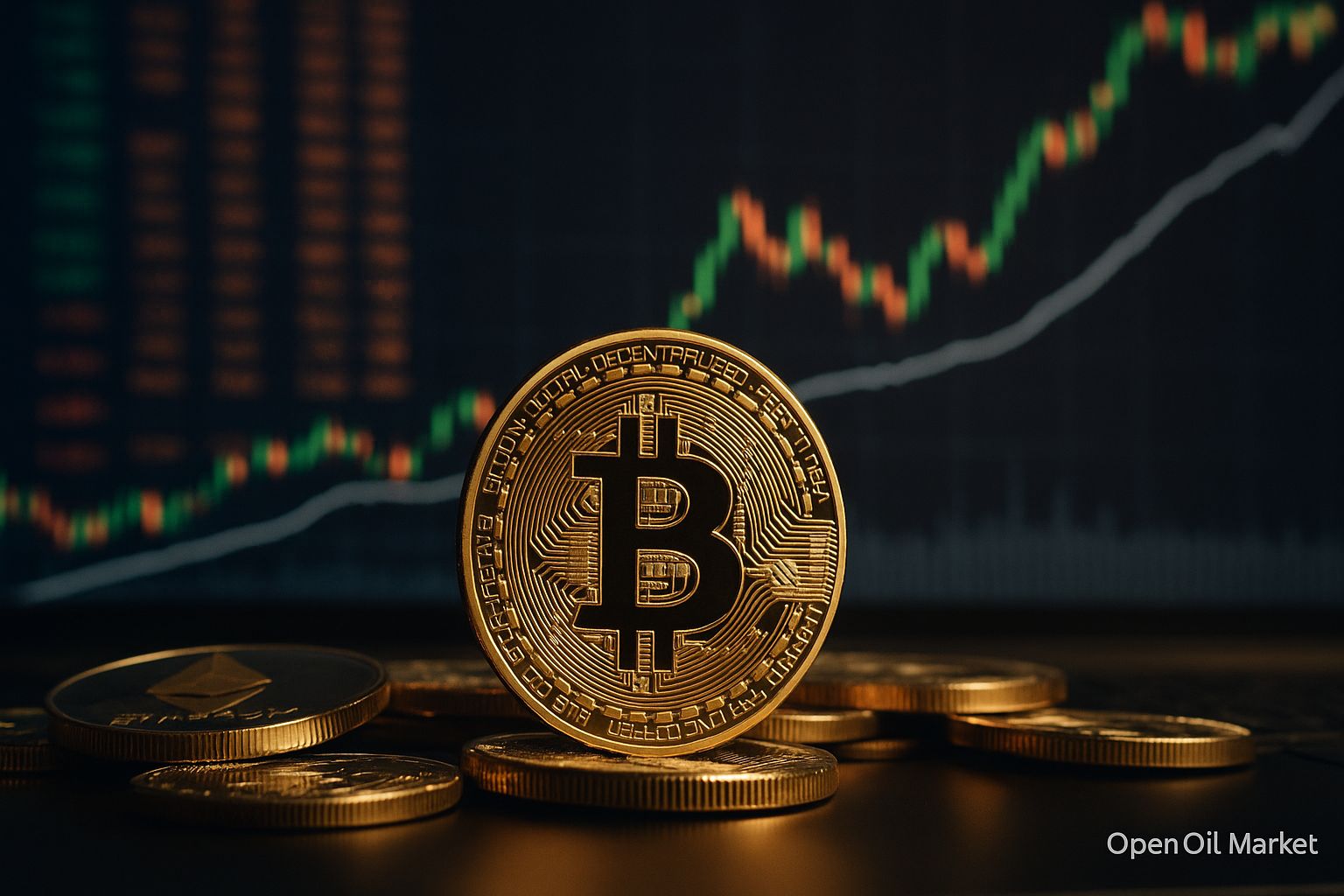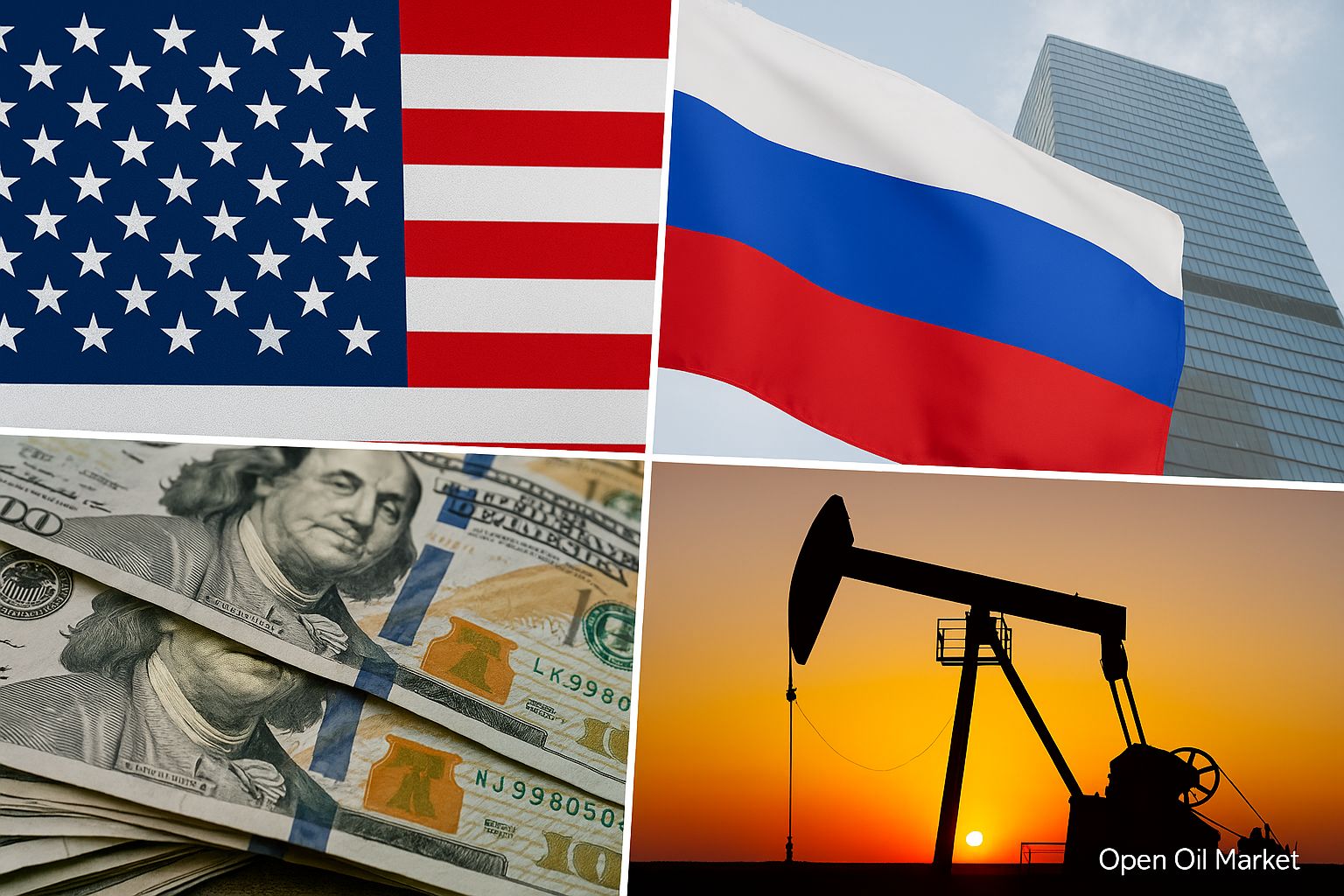
Current news in the fuel and energy sector as of August 9, 2025: U.S. sanctions pressure on India, stabilization of oil prices, export ban on gasoline from Russia, key events in the oil and gas and energy sectors.
Investors and market participants in the fuel and energy sector are summarizing the week: geopolitical tensions surrounding Russian oil are intensifying, yet commodity markets display signs of stabilization. The U.S. is increasing sanctions pressure on India, the second largest market for Russian oil, leading to retaliatory measures. Concurrently, global oil prices, which fell to a six-month low, are stabilizing due to a combination of market factors. Emergency measures are being taken in Russia's fuel sector to curb the rising prices of petroleum products, while the gas market remains relatively calm. A closer look at the key news and trends in the fuel and energy complex (oil, gas, electricity, renewable energy, coal, and petroleum products) as of Saturday, August 9, 2025, reveals much.
Oil market: prices rise from the downturn
After prolonged declines, oil prices found a local balance. Brent futures, having previously dropped this summer to around $58 per barrel (the lowest level since the beginning of the year), have stabilized this week in the range of averaging $60 per barrel. On Friday, Brent prices rose after six consecutive sessions of decline, signaling the end of the short-term downtrend. The oil market appears to have digested the negative news backdrop: despite the sanctions risks surrounding Russian oil and demand volatility, no supply disruptions are expected. Moreover, some market participants have started to factor in the possibility of easing geopolitical tensions. Notably, there are reports of U.S. President Donald Trump's willingness to meet with Vladimir Putin to discuss conflict resolution in Ukraine—this signal reduced oil risks in the eyes of investors. Additionally, physical market conditions are supporting prices due to fundamental factors: a global diesel fuel shortage and relatively low commercial oil stocks in the U.S. and Europe are constraining further price declines.
- Supply and demand balance: In the second half of the year, analysts previously predicted a surplus of oil amid slowing demand growth. According to OPEC's July estimates, global oil demand is expected to increase by only 1.3 million b/d in 2025, lower than the rates of 2024. Additionally, the IMF forecasts a slowdown in the global economy, including a GDP growth rate of about ~4% for China (the largest oil importer) in 2025. However, on the supply side, increases are not happening as rapidly as expected. OPEC+ countries are restoring production more slowly than the announced schedule: instead of the planned +960 thousand b/d in the second quarter, about 540 thousand b/d returned to the market. Some producers (Iraq, Russia) have had to compensate for previous overproduction, so the nominal quota increases have not led to an equivalent rise in actual output. Consequently, global "black gold" stocks remain below multi-year average levels (in particular, U.S. oil inventories stand at about 419 million barrels, which is below the five-year average), which supports prices.
- Regional demand factors: Seasonal oil consumption in the Middle East increased during the summer (more intense oil burning for electricity generation), while China took advantage of the declining prices to record levels of strategic stock replenishment (approximately up to 0.9 million b/d directed to reserves). These trends absorb some of the supply in the market and mitigate the effect of increased OPEC+ production.
Thus, the oil market has entered a phase of relative stabilization. Prices are consolidating around current levels, and future dynamics will depend on whether concerns about surplus outweigh the supply reduction factor and shortages of specific fuel types (e.g., diesel) continue to support prices.
U.S. sanctions pressure and India's position
Washington has intensified pressure on India in an effort to limit its collaboration with the Russian oil sector. U.S. President Donald Trump has signed an order imposing additional 25% tariffs on imports from India as a sanction for India's purchases of Russian oil. This measure, announced in early August, marks an unprecedented step directly aimed at the second largest market for Russian oil. The tariffs will take effect in a few weeks, and the U.S. administration has indicated its readiness to go further; should there be no changes from New Delhi, the potential for tightening trade restrictions may be considered (some sources report the possibility of doubling the tariff to 50%). The U.S. also does not rule out new sanctions against companies and the tanker fleet transporting Russian energy resources if progress in resolving the situation around Ukraine is not made. These actions demonstrate the U.S. desire to weaken Russia's export potential in the global energy market.
India, a major oil importer (~1.7–1.8 million b/d of maritime supplies from Russia in the first half of 2025), has reacted sharply to the sanctions pressure:
- The Indian government labeled the additional U.S. tariffs as "unfair" and destructive to its strategic partnership. New Delhi insists that the country’s oil deals are dictated by energy security and has no intention of sharply abandoning advantageous Russian oil.
- Major Indian refineries (Indian Oil, Bharat Petroleum, Hindustan Petroleum) have received instructions from authorities to refrain from new spot purchases of Russian oil until further notice. Essentially, India has paused increasing imports from Russia to assess the sanctions risks.
- Indian refiners have begun actively seeking alternatives: reports indicate that Hindustan Petroleum is exploring procurement options from other sources, while Indian Oil and Bharat Petroleum have contracted for at least 22 million barrels of non-Russian crude with delivery in September-October.
- Companies are also searching for alternatives in logistics: private Nayara Energy (partially owned by Rosneft), recently sanctioned by the EU, is seeking access to available tankers under Indian flags for transporting its petroleum products. Shipowners are wary of issues regarding insurance coverage for routes affected by sanctions.
- At the diplomatic level, India is not reducing dialogue with Moscow. Bilateral security negotiations took place in Moscow this week, where Russia and India emphasized their commitment to the status of "strategic partnership" between the two countries. This signals that despite Western pressure, New Delhi intends to maintain energy cooperation with Russia, at least in the context of long-term contracts.
- In response to the unfriendly actions of the U.S., India is considering retaliatory measures. Media reports suggest that New Delhi has decided to forgo some arms purchases from the U.S., indicating a willingness to protect its sovereignty regarding energy policy. Although not officially linked to oil, the message to Washington is clear.
The situation surrounding the Indian-American confrontation presents new challenges for the global oil market. Should India reduce purchases of Russian oil, Moscow will need to redirect additional volumes to China, Turkey, and other markets, potentially at even steeper discounts. Simultaneously, American producers might attempt to supply part of the Indian market: the U.S. has already stated its intention to become one of the key suppliers of oil and gas to Asian countries. Investors are closely monitoring developments, evaluating their impact on the redistribution of global oil flows and pricing dynamics.
Oil Price Forecast: Expert Opinions
Amid these conflicting factors, market participants are striving to understand the oil price outlook for the remainder of the year. Major international investment banks maintain relatively cautious forecasts. For instance, Goldman Sachs expects an average Brent price of around $64 per barrel in the fourth quarter of 2025, while Citi analysts anticipate a decline in prices to the low $60s by year-end. The main reasons for the cautious assessments are concerns about the slowdown of the global economy and the gradual increase of oil supply to the market. Investor focus is on OPEC+ policies and the behavior of major importers, which are crucial for market balancing.
Expert Comment: “Due to the slowdown in the global economy, the threshold of $70 per barrel will become critical for Brent oil prices in the remaining months of 2025,”—noted Sergey Tereshkin in a comment for RBC.
As the expert emphasized, the resumption of production under the OPEC+ agreement and declining demand create the prerequisites for a moderately downward trend. Indeed, after a brief summer increase to over $70, the market reverted to a downward dynamic. Should current forecasts be realized, the average Brent price for 2025 could be significantly lower than the previous year's level (for comparison, Brent averaged about $84/barrel in 2024). However, several factors might support prices: inventory reductions, geopolitical risks, and a possibly worsening situation with production (e.g., due to underinvestment in new fields). Overall consensus indicates that oil prices are unlikely to exceed the range of $60–70 before year-end, remaining under pressure from macroeconomic factors.
Russian Fuel Market: Measures and Indicators
In Russia's domestic market, fuel prices have become the foremost topic. The Russian government has taken decisive steps to stabilize the fuel situation: since the end of July, a full temporary export ban on gasoline has been imposed (initially until August 31, 2025) for all categories of exporters, including oil-producing companies. Previously, restrictions applied only to intermediaries (traders and oil depots), but the continued rise in gasoline prices in the domestic market necessitated the extension of the ban to the oil companies themselves. The primary reasons for this measure are fuel shortages in several regional markets, significant increases in gasoline prices at gas stations, and planned repairs at oil refineries that have reduced supply during the summer.
Oil companies and fuel organizations have reacted to the ban with mixed feelings. On one hand, the domestic market has received a signal prioritizing domestic consumer supply: more volumes of gasoline remain within the country, which should ease pressure on gas station networks. On the other hand, for the producers of petroleum products, this means lost profits from export sales (where prices are higher than domestic netbacks) and potential problems with fuel surpluses at storage facilities, especially in regions where seasonal demand is lower. The government is already discussing mechanisms to compensate oil refiners for part of the lost income through a damping mechanism or direct subsidies to curb wholesale price increases.
So far, the impact of these measures has been slight: retail prices for both gasoline and diesel fuel continued to rise across the country even after the export ban was imposed, although growth rates have slowed. This indicates structural problems in the market: high taxes and costs, limited competition in some regions, and price inertia. Nonetheless, it is expected that the situation will stabilize by the end of August once key refineries complete their repairs and return additional volumes of fuel to the market.
Against a backdrop of relatively low global oil prices, Russia's export revenue is also declining. According to the Russian Ministry of Finance, total oil and gas revenues for the budget in the first seven months of 2025 fell by about 18–19% compared to the same period last year, totaling around 5.5 trillion rubles. The primary factor is the decrease in prices for Russian oil of the Urals brand, which remains discounted due to sanctions and redirection to distant markets. Furthermore, reduced gas exports to Europe continue to adversely affect revenues. Simultaneously, non-oil and gas revenues are growing at a faster pace, partially compensating for the lost oil dollars. Russian authorities assure that the financial system is stable: reserve funds are being utilized to cover deficits, and the ruble remains manageable (around 80 rubles per dollar at the beginning of August, compared to 90-100 a year ago).
As for production, Russia generally adheres to OPEC+ restrictions, although in July, according to industry sources, Russian companies slightly exceeded the established quota (by approximately +27 thousand barrels per day over the limit). This minor excess may reflect an intent to maximize benefit before further tightening of quotas or anticipation of a softening of the deal. Nevertheless, Russian oil production remains below previous year levels, and exports have been redirected eastward: China, India, Turkey, and other CIS countries have increased purchases of Russian crude, albeit at reduced prices. Should sanctions pressure persist, Russia's focus shifts towards maintaining export volumes through its own tanker fleet and settlement schemes in national currencies to minimize the impact of Western restrictions.
Gas Market: Calm Amid Summer
The natural gas market remains relatively stable in summer 2025, especially compared to last year's price spikes. By the end of this week, exchange gas prices in Europe have slightly decreased, stabilizing around €33 per MWh (approximately $390–400 per thousand cubic meters). A slight decrease has been noted over the week, and while prices traditionally increase on Fridays due to short position closing, overall gas demonstrates low volatility. This is supported by comfortable stock levels: gas storage facilities in the EU are filled significantly above the average for this time of year, thanks to a mild winter and stable LNG imports. Gas demand in Europe this summer is moderate—relatively cool weather has reduced gas consumption for electricity generation by ~15% compared to last year, as the need for intensive cooling has not arisen.
In the U.S., the gas market also shows resilience. The spot price at Henry Hub hovers around $3 per MMBtu, with slight fluctuations. The latest EIA report noted an increase in gas prices at most hubs during the first week of August amid local demand spikes; however, the situation is generally balanced. Overall natural gas consumption in the U.S. even declined by nearly 10% over the past week, primarily due to the power sector (power plants reduced gas combustion by ~15% owing to cooler weather). At the same time, U.S. LNG export volumes have increased slightly—export terminals ramped up shipments by about 6%, continuing to operate close to maximum capacity.
Global prices for liquefied natural gas remain at relatively comfortable levels: in Asia, spot prices hover around $12 per MMBtu, closely aligned with prices at the European TTF gas hub ($11–12). This is significantly lower than last year's peaks, indicating a balance in the global gas market. Additional downward pressure on prices has been applied by political news: reports of possible direct negotiations between the U.S. and Russia aimed at reducing geopolitical tension have been interpreted as a factor mitigating risks for gas supplies. Amid these rumors, early August European gas futures dropped by about 2–3%, reflecting optimism regarding future supply stability. However, the upcoming autumn-winter season has market participants closely monitoring storage levels and potential weather risks that might alter price dynamics.
Coal and Energy Transition: Conflicting Trends
The coal market displays interesting dynamics. Prices for thermal coal in Asian markets have risen: the cost of Australian coal (a benchmark export variety from Newcastle) reached about $113 per ton in July, the highest level in the past six months. In comparison, prices were around $109 in June and had peaked at $119 earlier in the year. The rise in Australian coal prices has continued for three consecutive months, driven by strong demand in Asian countries (including China and India) and a slight reduction in supply from alternative sources. For instance, coal production in Indonesia decreased by ~9% during the first half of the year due to uncharacteristically heavy rains, limiting supplies and redirecting some demand towards Australian coal. Conversely, prices for South African coal, aimed at European and Middle Eastern markets, have declined; in July, prices were approximately 4% lower than the previous month (~$94 per ton compared to ~$98 in June). This reflects declining demand for coal in Europe, where renewable energy growth and high fuel stocks lessen the need for expensive imported coal.
On one hand, the coal industry continues to play a significant role in energy supply. According to the IEA's forecast, global coal production in 2025 could reach a historic high of around 9.2 billion tons per year, despite efforts at decarbonization. High prices in recent years have prompted producers to increase output, with several countries (e.g., India, Indonesia, Russia) planning to maintain or even boost production to meet domestic and external demand. However, on the other hand, the long-term trend is clear: the global energy transition is gaining momentum, and renewable energy sources are gradually displacing coal from the power sector.
Renewable energy (RE) is achieving record growth. Experts estimate that by 2025 or 2026, total electricity generation from RE could surpass that of coal, making "green" energy the largest source of electricity in the world. Many countries are ramping up investments in solar and wind power plants. Recently, the European Commission approved a massive funding program for wind energy in France amounting to around 11 billion euros—these funds will accelerate the construction of new wind farms and help achieve renewable energy share targets. In China and India, dozens of gigawatts of renewable capacity are being commissioned annually, gradually reducing the need for coal in power plants. Even traditionally coal-dependent economies are seeking alternatives: for instance, South Africa plans to build a new large nuclear power plant with a capacity of 4 GW to replace part of its coal capacity and meet emission reduction targets.
The energy transition is reflected in investment trends within the industry. Oil and fuel companies are starting to adapt to the new reality. In the "big oil" sector, there is an increasing focus on cost optimization and diversification. Notably, this week British BP announced plans to cut about 15% of its workforce in a bid to enhance efficiency amidst the transition to low-carbon energy. This news underscores that while oil, gas, and coal will maintain their importance in the coming years, global players in the fuel and energy sector are already restructuring strategies, taking into account the growth of RE and tightening environmental regulations. For investors in the fuel and energy sector, the time has come when the ability to balance traditional businesses with investments in new directions will be critically important for sustainable development.




